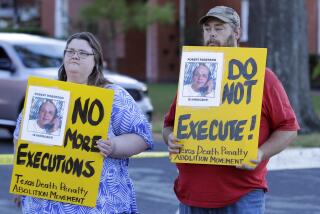Requiring Aid for Hopelessly Comatose Upheld
- Share via
WASHINGTON — The Supreme Court, acting Monday in a case that has alarmed emergency medical professionals, let stand a lower court ruling that requires hospitals to admit and resuscitate comatose patients, even when doctors say there is no hope for recovery.
The ruling grew out of the case of a baby born in 1992 in Fairfax County, Va., with most of her brain missing. Although she was deemed by doctors to have no chance of long-term survival, she was placed on a ventilator and has been repeatedly revived at her mother’s insistence.
Doctors disputed the wisdom of such aggressive treatment, but a divided U.S. appeals court ruled in February that federal law requires medical professionals “to provide stabilizing treatment” to a hopelessly ill patient, even when they “consider it morally and ethically inappropriate.”
Lawyers for several national medical groups, who pressed the case before the high court, said that the ruling greatly expands the prevailing interpretation of a 1986 federal law that barred hospitals from refusing to treat poor patients. Unless overturned, it could require hospitals to treat dying patients of all ages aggressively, no matter what their chances of survival, they said.
But in the matter of Baby K vs. Ms. H, 93-2076, the justices, without dissent, left standing the lower court ruling. In response, lawyers for the medical groups said that they will ask Congress to amend the law.
“This is the first time to my knowledge that a court has ordered physicians to render medical care over their protests,” said Stephan E. Lawton, an attorney representing the American Academy of Pediatrics and the Society of Critical Care Medicine. “Clearly, this is not what Congress intended, but the case is being cited now all over the country.”
The high court’s action Monday, the first day of its new session, does not set a binding legal rule. But as a practical matter, the precedent in the “Baby K” case is likely to be followed elsewhere.
Often the justices refuse to take up an appeal unless the lower courts are split on the matter. Lawyers said that the ruling in Baby K’s case marked the first time that the 1986 law had been deemed to mandate a level of medical treatment not recommended by doctors.
The U.S. appeals court in Richmond noted that Baby K “lacks a cerebrum (and) is permanently unconscious.” Doctors recommended that the baby be allowed to die peacefully, but the mother, citing her strong religious convictions, said she wanted “everything” done to keep her daughter alive. The baby continues to be cared for at a nursing home but has been returned to the hospital several times for resuscitation.
“It is beyond the limits of our judicial function to address the moral or ethical propriety of providing emergency stabilizing medical treatment to anencephalic infants,” wrote Judge J. Harvie Wilkinson for a 2-1 majority siding with the mother. “We are bound to interpret federal statutes in accordance with their plain language. The Emergency Medical Treatment and Active Labor Act does not carve out an exception for anencephalic infants in respiratory distress any more than it carves out an exception for comatose patients . . . who may repeatedly seek emergency stabilizing treatment.”
Congress passed the 1986 law in response to reports that some private hospitals were rejecting poor patients, including pregnant women in labor. Now hospitals that receive Medicare money must provide emergency care and “necessary stabilizing treatment” to all patients who arrive in medical distress.
Both sides in the Baby K matter agreed that money was not an issue in this case. An insurer paid the baby’s medical costs, which were sealed and kept confidential. They disagreed, however, about whether doctors must provide aggressive treatment in hopeless cases.
The Baby K ruling “will have sweeping and unintended implications for clinical medicine,” said lawyers for the hospital, if all “available technically feasible care will have to be provided to a dying patient upon demand. . . . This ruling has profound implications for the financing of medical care in this country.”
But a lawyer who represents the baby’s mother said the judges correctly concluded that the final decision about treatment should rest with the family, not the doctors.
“The hospital was trying to reverse 20 years of informed consent law,” said attorney Ellen J. Flannery. “Rather than let the family or patient decide, they said that ‘we, the hospital, can decide which cases are futile.’ ”
She cited the example of an AIDS patient who comes to a hospital with breathing difficulties. Doctors must try to revive such a patient, she said. “They can’t say, ‘We won’t treat you because you are going to die anyway.’ ”
Nearly 20 years ago, the case of Karen Ann Quinlan, a comatose teen-ager from New Jersey, helped to establish the legal principle in most states that family members can end extraordinary treatment for hopelessly ill relatives.
More to Read
Get the L.A. Times Politics newsletter
Deeply reported insights into legislation, politics and policy from Sacramento, Washington and beyond. In your inbox three times per week.
You may occasionally receive promotional content from the Los Angeles Times.











